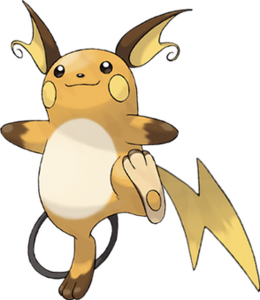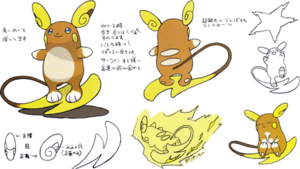Raichu facts for kids
Quick facts for kids Raichu |
|
|---|---|
| Pokémon character | |

Raichu artwork by Ken Sugimori
|
|
| First game | Pokémon Red and Blue (1996) |
| Created by | Atsuko Nishida |
| Designed by | Atsuko Nishida Ken Sugimori (finalized) |
| Voiced by |
Various
Kei Shindō
Fumiko Takekuma Casey Mongillo |
| In-universe information | |
| Species | Pokémon |
| Type | Electric Electric/Psychic (Alolan) |
Raichu ( Japanese: ライチュウ, Hepburn: Raichū) is a Pokémon species from the popular Pokémon world. It was created by Atsuko Nishida and is the evolved form of Pikachu, the series' famous mascot. Raichu first appeared in the video games Pokémon Red and Blue in 1996.
Raichu is an Electric-type Pokémon. It looks like a large orange mouse with a tail shaped like a lightning bolt. It has yellow pouches on its cheeks that can make a lot of electricity. To get a Raichu, a Pikachu needs to use a special item called a "Thunder Stone."
In 2016, a new version called Alolan Raichu was introduced in Pokémon Sun and Moon. This Raichu looks fluffier with rounder ears and tail. It can even float by riding its tail like a surfboard! Alolan Raichu is both an Electric-type and a Psychic-type Pokémon.
When Raichu first appeared, some people didn't like it as much because Pikachu was so popular. But over time, many fans have grown to love Raichu's design. In the Pokémon TV show, Raichu is often shown as a rival to Ash's Pikachu. This has led to interesting discussions about how the series shows Pokémon evolution and choices.
How Raichu Was Created
Raichu is one of the many fictional creatures called Pokémon. They were made for the Pokémon series, which started with video games in 1996. These games were developed by Game Freak and published by Nintendo. In the games, players become Trainers who catch and use Pokémon to battle others. Some Pokémon can evolve into stronger forms, often by using special items. Each Pokémon has one or two elemental types, which affect how they battle. A big goal in the games is to complete the Pokédex, which is like an encyclopedia of all Pokémon.
During the creation of the first Pokémon games, the lead designer, Ken Sugimori, wanted more "cute" Pokémon. He asked other Game Freak staff, including Atsuko Nishida, to help. Atsuko Nishida was given the task of designing Pikachu and its evolutions. She was told that Pikachu would be an Electric-type and would evolve twice, with the final form looking strong.
Pikachu evolves into Raichu when it uses a "Thunder Stone." Originally, Raichu was planned to evolve into another Pokémon called Gorochu. However, this idea was removed because of space limits on the game's cartridge. Later, a Pokémon called Pichu was created, which evolves into Pikachu. This completed the three-stage evolution line. Atsuko Nishida drew the first pictures of Raichu. Then, Ken Sugimori finalized the design and drew the official art for all the Pokémon.
Raichu's Look and Name
Raichu is much taller than Pikachu. It stands about 2 feet 7 inches (79 cm) tall, while Pikachu is about 1 foot 4 inches (41 cm). Raichu walks on two feet and looks like a rodent. It has long ears and feet, but short arms. Its skin is orange, with a white belly, brown paws, and tan soles on its feet. Its ears are brown on the outside and yellow inside. It also has yellow cheek pouches.
Raichu was not originally meant to be a mouse. Instead, it was based on squirrels. Atsuko Nishida liked squirrels because of their funny movements. She thought Pikachu and Raichu could store electricity in their cheeks, just like squirrels store food. However, Pokémon creator Satoshi Tajiri decided to make them mouse-like when he designed the game's world. Raichu's name comes from the Japanese word "rai," meaning thunder. "Chū" is the sound a mouse makes in Japanese.
When Pokémon Sun and Moon were being made, new "Alolan forms" of existing Pokémon were added. These forms were inspired by the Hawaii-like region in the game. The game director, Shigeru Ohmori, said that creating Alolan Raichu was the hardest. This was because Raichu was already very popular with fans. They decided to give Alolan Raichu a surfing theme because the game's region has a lot of water. This idea had been explored before with Raichu in another game, Pokémon Stadium.
Atsuko Nishida designed Alolan Raichu. She wanted it to look "soft and fluffy." When Ken Sugimori asked about the design, Nishida said the idea behind it was "bread." This confused him! The team later gave Alolan Raichu a love for pancakes to make it even cuter and connect it to the "bread" idea. Alolan Raichu was also given a second type, Psychic. It has a special ability called "Surge Surfer," which makes it faster in areas with "Electric Terrain."
Where You Can Find Raichu
Raichu first appeared in Pokémon Red and Blue and has been in most Pokémon games since then. In Red and Blue, a powerful Trainer named Lt. Surge uses a Raichu as a boss that players must defeat. Usually, players need to use a Thunder Stone on a Pikachu to evolve it into Raichu. However, the Pikachu you get at the start of Pokémon Yellow and Pokémon Let's Go Pikachu cannot evolve. You have to find another Pikachu to evolve into Raichu in those games.
In Pokémon Sun and Moon, the regular Raichu was not available. Instead, you could find its Alolan form. Both regular and Alolan Raichu have appeared in the mobile game Pokémon Go. They are also featured in the Pokémon Trading Card Game.
Outside of games, Raichu has appeared on many products. These include plush toys, figurines, and promotional items with companies like Burger King. Many of these items were part of product lines related to Pikachu, such as clothing, USB chargers, and special plush toys for claw machines.
In the Pokémon TV show and manga, Raichu is often a rival to Ash Ketchum's Pikachu. In one episode, Lt. Surge's Raichu easily beats Pikachu. Ash thinks about evolving Pikachu, but Pikachu refuses the Thunder Stone. Pikachu then battles Raichu again. This time, Pikachu wins by using skills that Surge's Raichu didn't have because it evolved too quickly.
Another Raichu appears in the short film Pikachu's Vacation. This Raichu challenges Pikachu to a fight and a race. In a later episode, Pikachu races an Alolan Raichu while carrying stacks of pancakes. Later in the anime, Ash's friend Goh owns a female Raichu. Many different voice actors have provided Raichu's voice, including Kei Shindō, Fumiko Takekuma, and Casey Mongillo.


